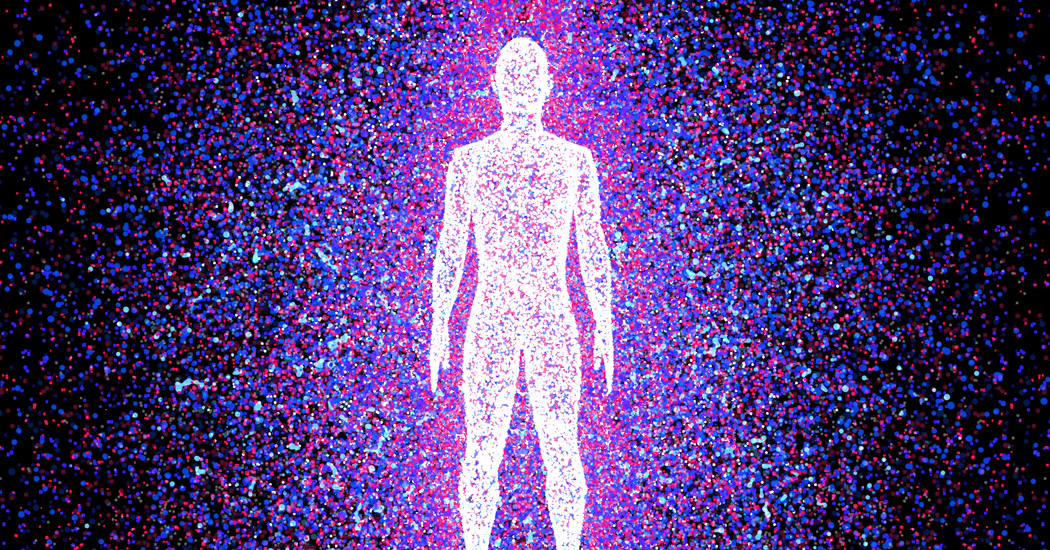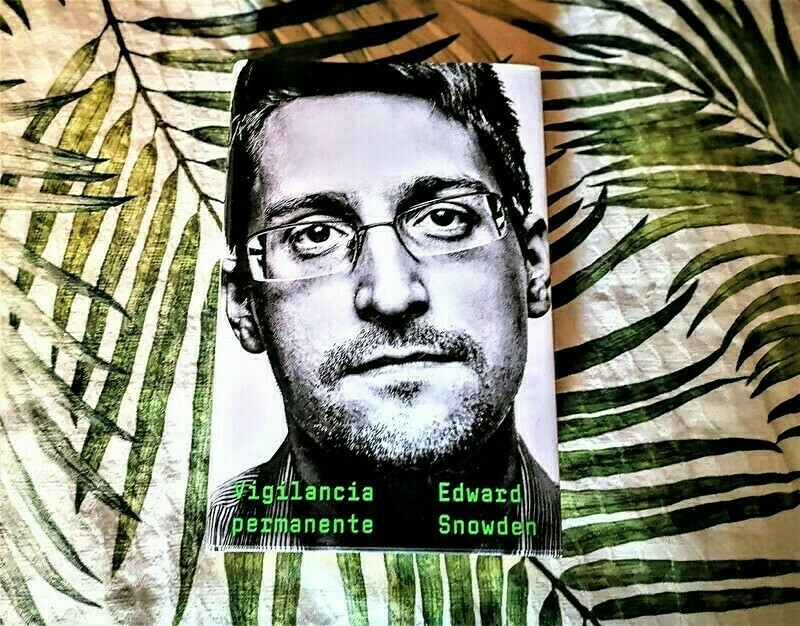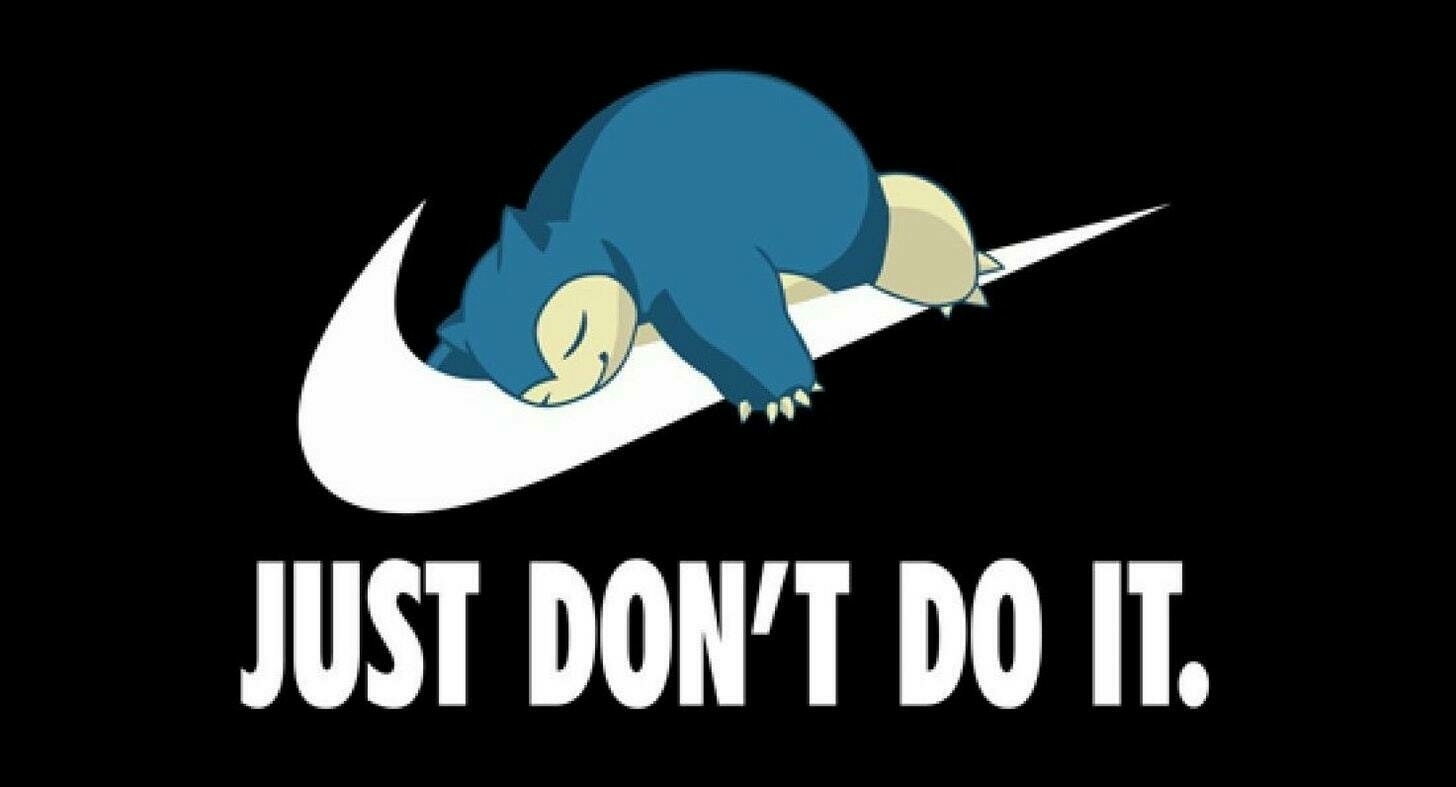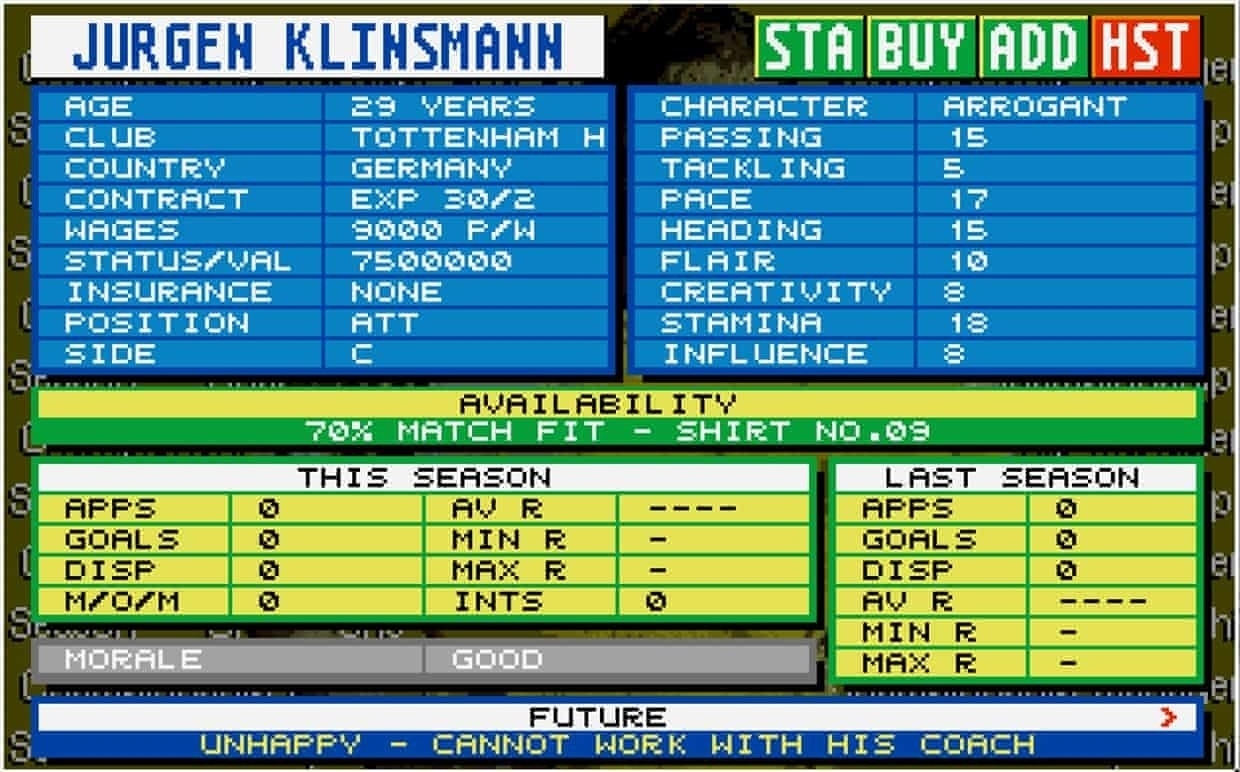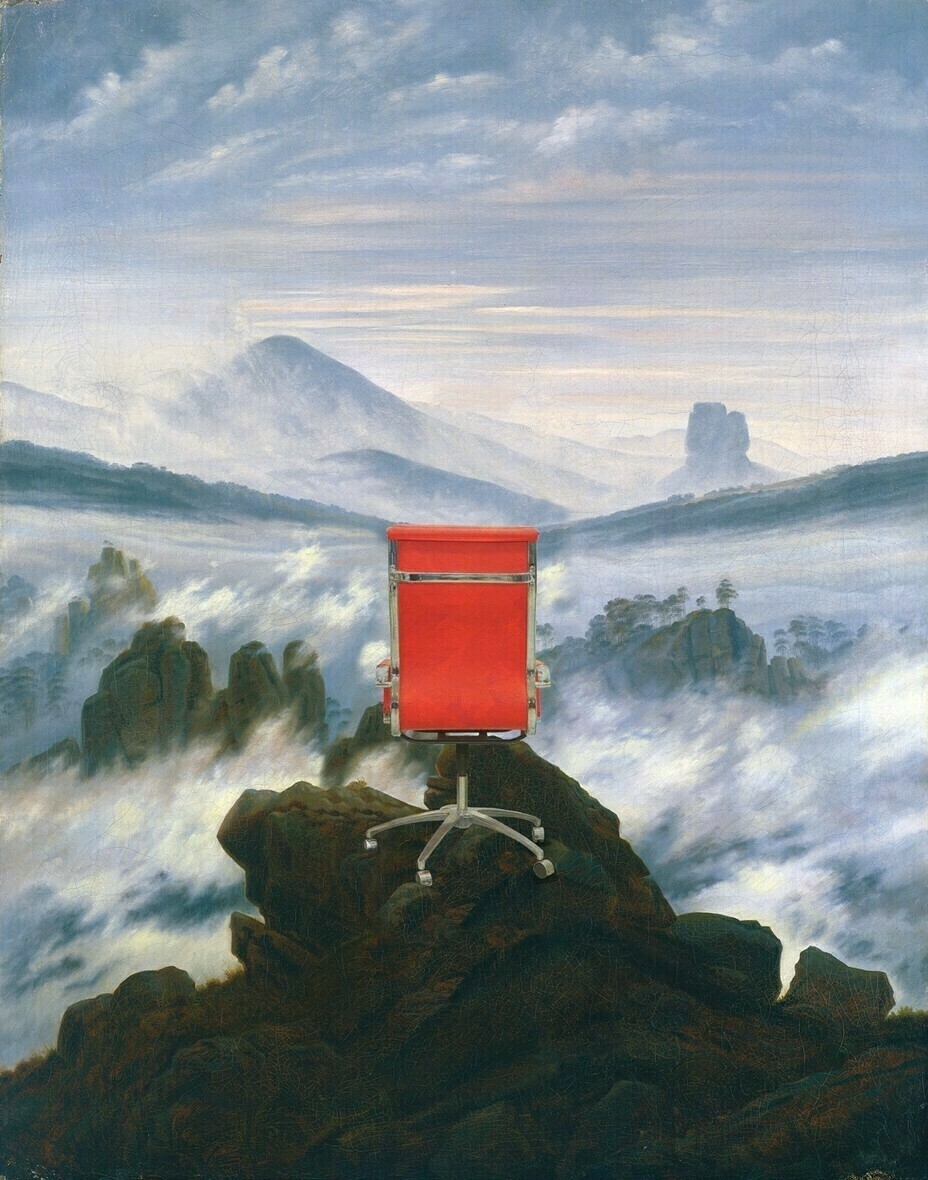Start Often Finish rArely
I love this, and along with this post about the joy of watching films in black and white, led to me starting a new art project.
SOFA is the name of a hacker/art collective, and also the name of the principle upon which the club was founded.Source: 🛋 SOFAThe point of SOFA club is to start as many things
as possibleas you have the ability, interest, and capacity to, with no regard or goal whatsoever for finishing those projects.[…]
You can be finished with your project whenever you decide to be done with it. And “done” can mean anything you want it to be. Whose standards of completion or perfection are you holding yourself to anyway? Forget about those! Something is done when you say it is. When it’s no longer interesting. When you’ve gotten a sufficient amount of entertainment and experience from it. When you’ve learned enough from it. Whatever, whenever. Done is what you say it is.
Pain, suffering, and scuba diving
In this post, Derek Sivers shares his experience of a panic attack during a scuba diving trip and being calmed down by his instructor. He then subsequently used the same technique to help someone else who wasn’t OK on a later trip.
Pain and suffering are part of the human experience. For anyone ask “why me?” doesn’t make sense. There are those who dissimulate and those who don’t, but underneath it all there is hardship.
There is less stigma around therapy than there used to be, but I haven’t met anyone (me included!) who hasn’t transformed their life for the better after going through some form of counselling.
I learned a few lessons from this experience.Source: scuba, panic, empathy | Derek SiversThere are things in life we think won’t apply to us: Panic. Addiction. Depression.
I thought that was for other people. I thought I wasn’t that type. Why is this happening to me?
But I learned so much empathy that day. These things that only seem to happen to other people can happen to me. We’re not so different. It helps me recognize it in others, and be most helpful by remembering that feeling.
I imagine this is why people, who have been through really hard times, become counselors.
That day also reinforced the power of imitation. My teacher calmed me down so well that it was best to just imitate him.
Introspections on timewasting
What I’ve learned over the years from my own experience is that what one person calls a “waste of time” is the complete opposite for someone else. It also has a temporal/timing element to it, as well, I’d argue.
For example, I spent an inordinate amount of time on Twitter between 2007 and 2012, but this paid off massively in terms of my career. I learned a lot and made really valuable connections in the process. My wife thought it was a waste of my time. These days, it absolutely would be.
In this post, the author reflects on why they “waste time” and look at different reasons as well as various ways they’ve sought to combat it. As someone who’s been through therapy, I’d suggest that there’s always something below the surface that needs a skilled professional to draw out.
That’s what seems missing here.
I spend way too much time on reddit, hacker news, twitter, feedly, coinbase, robinhood, email, etc. I’d like to spend time on things that are more meaningful - chess, digital painting, side projects, reading, video games, exercising, meditating, etc. This has been a problem for years.Source: Scattered Thoughts on Why I Waste My Own Time | Just a blogThis post is only slightly adapted from my personal notes, so excuse the lack of structure; I didn’t want to try to twist this jumble of thoughts into a narrative.
Image: CC BY mysza831
Should teenagers be using social media? We probably already know the answer
While I’m not a fan of Nicholas Carr’s approach to technology (“is Google making us stupid?") I do have sympathy with Cal Newport’s more nuanced and considered approach.
Writing in The New Yorker, Newport considers whether we should be allowing teenagers to use social media at all. By this, he doesn’t mean the ‘social internet’, which I explore further in this post.
Our son turns 15 soon and while we’ve grudgingly allowed him to use WhatsApp (I don’t use any Facebook Meta products) he isn’t allowed an Instagram, Twitter, or TikTok account. Digital parenting is a thing.
I’m not sure, however, that we should be so quick to give up on interrogating the necessity of these technologies in our lives, especially when they impact the well-being of our children. In an attempt to keep this part of the conversation alive, I reached out to four academic experts—selected from both sides of the ongoing debate about the harm caused by these platforms—and asked them, with little preamble or instruction, the question missing from so much of the recent coverage of the Facebook revelations: Should teen-agers use social media? I wasn’t expecting a consensus response, but I thought it was important, at the very least, to define the boundaries of the current landscape of expert opinion on this critical issue.Source: The Question We’ve Stopped Asking About Teen-Agers and Social Media | The New Yorker[…]
For a particularly dispiriting case study of how long it sometimes takes to establish definitive causation between behaviors and negative outcomes, consider the effort involved in connecting smoking to lung cancer. The first major study showing a statistical correlation between cigarettes and cancer, authored by Herbert Lombard and Carl Doering of the Massachusetts Department of Public Health and the Harvard School of Public Health, was published in 1928. I recently came across an article in the archives of The Atlantic from 1956—nearly thirty years later—in which the author was still trying to convince skeptics who were unhappy with the types of confounding factors that are unavoidable in scientific studies. “If it has not been proved that tobacco is guilty of causing cancer of the lung,” the article pleads, “it has certainly been shown to have been on the scene of the crime.”
[...]What is obvious, however, is that regardless of what answers we end up with, we need to keep debating these fundamental questions. As Zuckerberg emphasized in his defensive post, he wants us to concede that his products are inevitable, and that we have no choice but to move on to discussing their features and safeguards. We might think we’re really sticking it to these social-media giants when we skewer their leaders in congressional hearings, or write scathing commentary pieces about the shortcomings of their moderation policies, but, in some sense, this response provides a reprieve because it sidesteps the conversation that these companies are trying hardest to avoid: the conversation about whether, in the end, the buzzy, digital baubles they offer are really worth all the trouble they’re creating.
Freedom for the few vs. freedom for the many
My wife and I were talking about lockdowns yesterday given that we’re due to be travelling to the Netherlands next month and they’ve announced a partial lockdown. I can’t imagine something similar would be accepted in the UK — by which I mean it would probably be difficult to enforce.
Austria are imposing a nationwide lockdown for unvaccinated people. This sounds like a good solution for those vaccinated, but (a) there’s non-conspiracy reasons why people aren’t vaccinated, and (b) whatever means are used to prove vaccinated will be instantly forged.
It’s a problem, for sure, how to protect the freedoms of everyone.

Austria will impose a nationwide lockdown for people who have not been vaccinated against COVID-19, becoming the first country in the world to do so, Chancellor Alexander Schallenberg announced on Friday.Source: Austria to declare nationwide lockdown for unvaccinated people | BNO News[…]
“A lockdown for the unvaccinated means one cannot leave one’s home unless one is going to work, shopping (for essentials), stretching one’s legs – exactly what we all had to suffer through in 2020,” Schallenberg said earlier, according to Reuters.
The lockdown for the unvaccinated has already been formally approved in Upper Austria, where restrictions have also been announced for the entire population. This includes a legal requirement to wear an FFP2 mask in all indoor public places and a ban on events for 3 weeks.
[…]
However, questions have been raised about the feasibility of a lockdown which applies to only a part of the population. “We don’t live in a police state and we can’t and don’t want to check every street corner,” Schallenberg said.
Games as a cultural, educational, and predictive force
As a gamer, I grow frustrated with people who don’t consider games to be an art form and vehicle for stories comparable with other cultural pursuits.
Take for example one of the biggest games of this year, the recently released Battlefield 2042. Not only is it a technical and cultural milestone, but it presents a plausible timeline for how things could go given our current trajectory: climate, migration, wars, you name it.
I highly recommend watching this 9-minute short film:2037
Humanity adapts to the new normal. Revolutions in energy, desert irrigation, hydraulic levees, and sea walls save coastal cities, reclaim farmland, and rebuild supply chains. Hope of finding stability leads to some nations re-opening their borders.
However, with no way to repatriate 1.2 billion people, No-Pats become a permanent fixture in all economic, military, and social policy making. Many No-Pats are still distrustful of the governments that exiled them and refuse calls to reassimilate. No-Pat leaders emerge, inspiring a new identity unbound to former nationality, drawing a line in the sand between the Old World and The New Normal. #WeAreNoPats becomes a rallying cry.
[embed]www.youtube.com/watch
Big Tech companies may change their names but they will not voluntarily change their economics
I based a good deal of Truth, Lies, and Digital Fluency, a talk I gave in NYC in December 2019, on the work of Shoshana Zuboff. Writing in The New York Times, she starts to get a bit more practical as to what we do about surveillance capitalism.
As Zuboff points out, Big Tech didn’t set out to cause the harms it has any more than fossil fuel companies set out to destroy the earth. The problem is that they are following economic incentives. They’ve found a metaphorical goldmine in hoovering up and selling personal data to advertisers.
Legislating for that core issue looks like it could be more fruitful in terms of long-term consequences. Other calls like “breaking up Big Tech” are the equivalent of rearranging the deckchairs on the Titanic.
Democratic societies riven by economic inequality, climate crisis, social exclusion, racism, public health emergency, and weakened institutions have a long climb toward healing. We can’t fix all our problems at once, but we won’t fix any of them, ever, unless we reclaim the sanctity of information integrity and trustworthy communications. The abdication of our information and communication spaces to surveillance capitalism has become the meta-crisis of every republic, because it obstructs solutions to all other crises.Source: You Are the Object of Facebook’s Secret Extraction Operation | The New York Times[…]
We can’t rid ourselves of later-stage social harms unless we outlaw their foundational economic causes. This means we move beyond the current focus on downstream issues such as content moderation and policing illegal content. Such “remedies” only treat the symptoms without challenging the illegitimacy of the human data extraction that funds private control over society’s information spaces. Similarly, structural solutions like “breaking up” the tech giants may be valuable in some cases, but they will not affect the underlying economic operations of surveillance capitalism.
Instead, discussions about regulating big tech should focus on the bedrock of surveillance economics: the secret extraction of human data from realms of life once called “private.” Remedies that focus on regulating extraction are content neutral. They do not threaten freedom of expression. Instead, they liberate social discourse and information flows from the “artificial selection” of profit-maximizing commercial operations that favor information corruption over integrity. They restore the sanctity of social communications and individual expression.
No secret extraction means no illegitimate concentrations of knowledge about people. No concentrations of knowledge means no targeting algorithms. No targeting means that corporations can no longer control and curate information flows and social speech or shape human behavior to favor their interests. Regulating extraction would eliminate the surveillance dividend and with it the financial incentives for surveillance.
Momentum over details
I subscribed to Laura Olin’s newsletter recently, and the first issue I received mentioned how the late Dave Graeber “liked to… write propped up in the bathtub or lying on the floor; that way, it didn’t feel like work”.
She also links to another newsletter issue by Kate McKean, which I quote below, about just getting on with things, keeping the momentum going, and not getting stuck with details. It reminds me of my collaborations this week (in a good way!)
Which leads me to my newest revelation: just write it down now! You can fix it later! Truly and honestly, you can fix it later. Do you know how many TKs are in my book right now? (TK is copyediting shorthand for I’ll fill it in later) Instead of trying figure out what day of the week it is in my book, it literally says “TK weekday.” I was in the middle of a scene when I realized one of the characters in it couldn’t physically be there at that time, so I deleted his name and wrote “TK some other guy” and kept going! I liked the scene! I’ll figure out that TK later! Or I will cut it! The words exist now, which means they can be edited, refined, deleted, kept. You’re going to edit your book five thousand times; you won’t notice one more. And for those of you who worry that’s going to add time to an already long and arduous process, well, I say that if it gets you to The End faster, even if you have to go back to all those TK’s, you’re that much better off.Source: How to Like What You Write | Kate McKean
Image: CC BY-NC-ND Alan Bloom
Aimless wandering in search of the unknown catalyst
It might not be too much of a stretch to describe Edward Snowden as a hero of mine. I’m not sure what he’s still doing in Russia, but the moral conviction it took to do what he did is staggering.
He writes in exile through a newsletter which is well worth subscribing to. In his most recent missive, he talks about lacking what he calls “origination energy”. On a much smaller level and more insignificant level, I lack this too — especially at this time of year.
So as the young people say, I feel seen.
For a long time now, I’ve wanted to write to you, but found myself unable. Not from illness—although that came and went—but because I refuse to put something in your inbox that I feel isn’t worth your time.Source: Cultural Revolutions | Edward SnowdenThe endless stream of events that the world provides to remark upon has the tendency to take on an almost physical weight, and robs me of what I can only describe as origination energy: the creative spark that empowers us not simply to do something, but to do something new. Without it, even the best of what I can produce feels derivative and workmanlike—good enough for government, perhaps, but not good enough for you.
I suspect you may know a similar struggle—you can tell me how you fight it below, if you like—but my only means for overcoming it is an aimless wandering in search of the unknown catalyst that might help me to refill my emptied well. Where once I might have had a good chance of walking away inspired by the empathy I felt while watching a sad, sad film, achieving such inspiration feels harder now, somehow. I have to search farther, and wander longer, across centuries of painting and music until at last, when passing by a dumpster, yesterday’s internet comment might suddenly pop into my head and blossom there, as if a poem. The thing—the artifact itself—doesn’t matter, so much as what it does for me—it enlivens me.
This, to me, is art.
Image CC BY-NC-ND: Antonio Marín Segovia
Surveillance vs working openly
Austin Kleon is famous for his book Show Your Work, something that our co-op references from time to time, as it backs up our belief in working openly.
However, as Kleon points out in this post, it doesn’t mean you need to livestream your creative process! For me, this is another example of the tension between being able to be a privacy advocate at the same time as a believer in sharing your work freely and openly.
It’s bad enough trying to create something when nobody’s watching — the worst trolls are the ones that live in your head!Source: You can’t create under surveillance | Austin KleonThe danger of sharing online is this ambient buildup of a feeling of being surveilled.
The feeling of being watched, or about to be watched.
You have to disconnect from that long enough to connect with yourself and what you’re working on.
A Timeline of Earth's Average Temperature
I can’t argue with every anti-vaxxer and climate denialist, but I can debate a few on my timeline. And this xkcd is another useful thing to point towards when they talk about how climate change is nothing new…
Source: xkcd: Earth Temperature Timeline
Platform power and infrastructure
John Naughton writes notes that we need to describe a fourth kind of power alongside compelling us to do something, stopping us from doing something, or shaping the way we think.
The great unsolved problem of our time is how to deal with – and where necessary curb – the unaccountable power of these giants. The first step on that road is to reach a collective understanding of what kind of power they actually wield. And for that we need a taxonomy. In an earlier era, the political theorist Steven Lukes proposed one. There were, he said, three kinds of power: the ability to compel people to do what they don’t want to do, the ability to stop them doing something they want to do and the ability to shape the way they think. This last one was useful in addressing the power of influential media owners (Rupert Murdoch, for example) in the old media ecosystem. But although it still applies in some ways to social media, it’s less useful for the networked ecosystem we now inhabit; we need another category.Source: How can we tame the tech giants now that they control society’s infrastructure? | The Guardian“Platform power” is one possibility. The tech giants all possess it to a greater or lesser degree. In Apple’s case, for example, it owns and controls two important platforms – ie, software systems on which other agents can build businesses: they are the operating systems on which its devices run and its app store, which decides what apps are allowed on Apple devices. Google owns several platforms – a search engine and its associated advertising marketplace, the Android mobile operating system, YouTube and Google cloud services. Facebook (whose holding company is now rebranded as Meta) also owns several – Facebook, Instagram and WhatsApp; Twitter owns, er, Twitter; Amazon owns its marketplace and cloud services; and Microsoft owns the Windows/Office platform and a fast-growing cloud service, Azure.
Proving endemic racism and sexism in the world of football
Anyone who follows football will perhaps be disappointed yet unsurprised that racism and sexism continue to be part of the beautiful game.
This study is clever in the way that it shows that those watching football matches use coded language and are biased against women. Hopefully, it will help all of us figure out better ways forward.
(I actually really enjoy watching women’s football with my family!)
The resulting paper, “Pace and Power: Removing unconscious bias from soccer broadcasts,” caused a stir when they presented it at last month’s New England Symposium on Statistics in Sports. Of the 47 sports fans who watched a two-minute clip of the World Cup TV broadcast, 70 percent said that Senegal, whose players were all Black, was “more athletic or quick.” But of 58 others who saw an animation of the same two minutes without knowing which teams they were watching, 62 percent picked Poland, whose players were all white, as the more athletic side.1 The physical advantages that supposedly defined the African team’s style of play disappeared as soon as their skin color did.Interestingly, they also looked at gender as well as race:[…]
The athleticism flip-flop offers a new kind of evidence of a prejudice that affects how Black players of every nationality are perceived. For decades, researchers have documented media stereotypes of African players as “‘powerful,’ ‘big-thighed,’ ‘lithe of body,’ ‘big,’ ‘explosive,’ and like ‘lightning,’ attributes that were to be contrasted with ‘the know-how that England possess.’” As Belgian forward Romelu Lukaku, who is Black, told The New York Times, “It is never about my skill when I am compared to other strikers.” Now, for the first time, researchers have a way to isolate how race influences direct perceptions of the game.
The study also examined attitudes toward gender by showing viewers a pair of two-minute clips, one from the American top-flight National Women’s Soccer League and another from League Two, the English men’s fourth tier. Even though the NWSL draws more fans to games, its average player earns about a quarter as much as the average player in League Two. Gregory and Pleuler were curious whether this “clear gender pay gap” could be explained by a difference in the quality of the soccer shown on TV, as some have argued.Source: Soccer Looks Different When You Can’t See Who’s Playing | FiveThirtyEightPeople who watched the broadcasts said that the men’s game was “higher quality” by a 57 percent to 43 percent margin. Those who saw the renders with genderless stick figures preferred the women’s match, 59 percent to 41 percent. The results weren’t statistically significant across a small sample of 105 mostly male respondents, but Pleuler believes the line of research is promising. “I think these results are suggestive that your average soccer fan can’t tell the difference between something that does have a large investment level and the women’s game, which does not,” he said.
Just Don't Do It
This isn’t an easy article to cite, mainly because I want to quote both it and some commentary by Andrew Curry. The original article is paywalled, so I’m going to rely on Curry’s quotations.
I’m particularly interested in this because I’m one of the oldest Millennials (I was born nine days before the end of 1980). There’s something about my generation whereby we’re just not going to take that Boomer shit any more.
It turns out the latest moral panic about work —at least, abut our contemporary idea of work—is being fuelled by ‘The Great Resignation’ in the US, which I wrote about here recently. (‘The four Rs of post-pandemic America.’)Curry quotes Lowry as saying:One of the elements of this is that it is Millennials who are disproportionately more likely to quit. One might say, ‘what are these young people thinking of?’, were it not for the fact that the oldest Millennials are 41 this year; half a lifetime in, in other words.
The writer Erin Lowry, who has written multiple books on Millennials, and is a Millennial herself, is having none of it. In a (partly gated) short column in Bloomberg, she suggests instead that the games’s up for the version of work that has been normalised in the last two decades.
After 18 months of pandemic uncertainty altering how we work, it makes sense we’d return to the questions of why we work, and how our jobs affect our quality of life. Is there perhaps another way to earn an income that better aligns with our overall goals? Couldn’t we create a future of no longer using a career as the primary or sole basis of our identity and self-satisfaction? Shouldn’t this be a moment to consider how to work to live instead of live to work?Source: Work | Ancestors | Just Two Things[…]
We can theorize that this burnout comes from the increasingly blurred boundaries between being on and off the clock. From being conditioned to believe that appearing “always available” is the hallmark of a promotable employee. From jobs that once required a high school diploma suddenly demanding a bachelor’s degree, forcing young people to get mired in never-before-seen levels of student loan debt.
Carbon emissions per km
Now that I'm not flying any more, I need to figure out ways to get to places where I'd usually travel by plane.
For example, I'm travelling to the Netherlands next month. Fortunately, instead of having to go down from the north of England, through London, and then across to Paris and then Amsterdam, I can take the ferry.
But what about the carbon emissions of ferries? Thankfully, for foot passengers they are, on average, even smaller than those of coaches.

Train virtually always comes out better than plane, often by a lot. A journey from London to Madrid would emit 43kg (95lb) of CO2 per passenger by train, but 118kg by plane (or 265kg if the non-CO2 emissions are included), according to EcoPassenger.
[...]
The [Department for Business, Energy and Industrial Strategy] has also put a figure on ferry transport - 18g of CO2 per passenger kilometre for a foot passenger, which is less than a coach, or 128g for a driver and car, which is more like a long-haul flight.
Source: Climate change: Should you fly, drive or take the train?
Whitelabelling Stadia tech
I recognise that this is rather niche, but as a fan of Google Stadia, this is great to see. For some reason, there’s a lot of people who seem to want cloud gaming… not to work?
The thing is that it’s here, working, and pretty awesome. Yes, there’s rough edges at times, but the technology and culture around it is a lot less mature than the more traditional model.
“This is being powered by the Stadia technology,” an AT&T representative tells The Verge. “For this demo AT&T created a front end experience to enable gamers to play Batman Arkham Knight directly from their own website and the game is playable on virtually any computer or laptop.” Although AT&T calls it a “demo,” there’s no mention of length, as shown in a short walkthrough of the experience.Source: AT&T is white-labeling Google Stadia to give you free Batman game streaming | The VergeAT&T also adds that you can stream Arkham Knight at up to 1080p and 60fps, which is the same performance you’ll get if you use Stadia for free. Paid Stadia Pro subscribers have the ability to stream up to 4K at 60fps, for which AT&T doesn’t offer an option. On the Arkham Knight page, AT&T notes that the game will be “available for a limited time.”
We also asked AT&T whether the company would be working on similar Stadia-powered games in the future or if it planned on establishing a game streaming service for customers. AT&T wasn’t able to share any additional details, but its dip into Stadia technology may open the door for other companies to follow suit.
Build your 'castle' on land you own and control
This post is ostensibly about marketing a game studio, but it has wider lessons for all kinds of creators. Long story short? Don’t get seduced by ‘exposure’ but instead spend your time directing people towards places that you own and control.
The metaphors and graphics used are lovely, so be sure to click through and read it in its entirety!
Your game studio is basically your land. You are the king. You can do whatever you want on this plot of land and kick out who you want, charge what you want. Set the rules.Source: Don’t build your castle in other people’s kingdoms | How To Market A GameGoal here: You want to grow from this little tiny hamlet to a giant castle. You also want a bunch of people in your kingdom living there (aka playing your games), and paying you taxes (buying your games) and telling you how brilliant of a leader you are (fan mail, fan art) and enjoying the company of your kingdom’s fellow citizens (community engagement).
[…]
It is hard to make people leave a social media site. But you need to work hard at it.
With every single person who enters your castle in a foreign land, tell them “welcome, yes my castle is nice here, but did you know I do better stuff over there in that Kingdom across the sea?”
Always be working to get people over to your land.
Retro football gaming FTW
The amount of nostalgia that this article gave me was incredible. I have spent more time with the Championship Manager series of games (now Football Manager) than any game. Even FIFA.
Perhaps because it was a formative period in my life, but Championship Manager 93 and Championship Manager Italia were perhaps may favourite. I can remember playing one of them on the bus to a football tournament in Blackpool on my Dad’s laptop (with a monochrome screen!)
Theoretically, you can play these games via archive.org. But the links weren’t working for me when I tried them…
And then there was Championship Manager. The king of them all. It’s hard to explain why. It took 10 minutes to get through the classified results each week. There were about three tactics you could adopt. There was no training. But somehow it just worked. That old man on the cover pretending to be a manager pointing at you in his sheepskin coat.Source: No passing, no training, seven discs: the joys of 90s football gaming | The Guardian[…]
I recently downloaded Championship Manager 93 on my laptop. It runs slightly more quickly on a Mac. I took Cambridge United to the top of the Premier League. A front line of Darrell Powell, Dominic Iorfa and Nick Barmby were unstoppable.
How to communicate remotely
I’ve worked from home for almost a decade now and still find posts like this incredibly instructive. Not only does Olivier Lacan go through gear, but also how to set it up.
In addition, there’s a few useful tips in here about remote etiquette and when to jump on a call instead of continuing a back-and-forth via text.
By definition being remote means not being there. But feeling present goes a long way. A simple look can trigger a strong reaction and a sense of shared understanding. A slight change in intonation can convey doubt or excitement better than a paragraph. Cameras can’t magically make your expressions visible when light isn’t bouncing off your face. Backlighting or contre-jour for example is a very common mistake that I see very smart people make over and over again, even during important video calls featuring very important people you’d assume would have staff to assist them.Source: High Fidelity Remote Communication | Olivier Lacan[…]
The one-stop-shop doesn’t exist quite yet, but I can tell you from experience that you can already communicate remotely with higher fidelity than the majority of office workers through the world did even before the pandemic. While your three-dimensional presence will never be replaceable, it’s possible for two-way communication to have an unprecendented amount of subtlety.
[…]
It’s the responsibility of employers to deploy the kind of budgets already allocated toward in-office communication to remote work equipment. It’s also the role of folks like me (and you) to help educate IT departments and business leaders on hardware solutions that already exist today.
It has become quite absurd to argue that remoteness has to mean becoming a less visible and valued contributor to your organization. I hope this post can help you convince anyone who might still believe that communicating remotely still has to be a pain.
Exploration pays long-term dividends for your career
This article focuses on the work of Dashun Wang, an economist at Northwestern University, who has looked at ‘hot streaks’ in the careers of regular people.
It comes down, apparently, to exploring areas and then exploiting them. I would translate that into British English as “pissing around with stuff that looks interesting until you find a use for it”.
The conventional wisdom is that hot streaks happen in our middle age. One famous analysis of scientists and inventors found that their ability to produce Nobel Prize–winning insights and landmark technological contributions peaks between the ages of 35 and 40. Another analysis of “age-genius curves” for jazz musicians found that musical productivity rises steadily until about the age of 40 and then declines sharply.Source: Hot Streaks in Your Career Don’t Happen by Accident | The AtlanticWang’s analysis—which used a broader measure of productivity for a much larger group of people—didn’t find anything special about the productivity of middle-aged people. Instead, hot streaks were equally likely to happen among young, mid-career, and late-career artists and scientists. Other theories fell flat too. Maybe, he thought, getting hot is a numbers game, and hot streaks happen when you produce the most work. Or maybe extremely successful work periods are all about focusing on one specific type of art or scientific discipline—as the 10,000-hours-of-practice rule popularized in Malcolm Gladwell’s book Outliers suggests. Or maybe hot streaks are more about who else we’re working with, and we’re most successful when we cozy up to superstars in our domain. But no explanation fit the data set.
Until this year. This summer, Wang and his co-authors published their first grand theory of the origin of hot streaks. It’s a complicated idea that comes down to three words: Explore, then exploit.





